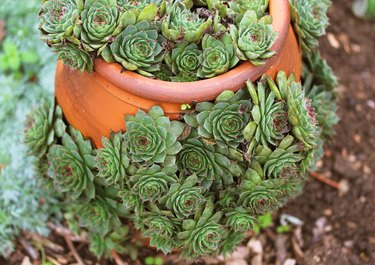
A cute common name like "hens and chicks plant" inspires gardeners to nurture these succulents, but hens and chicks are tough, low maintenance plants that are winter hardy in most regions of the continental United States. They are perfect succulents for beginning gardeners and expert gardeners alike.
Meet the Hens and Chicks Plant
Video of the Day
Hens and chicks plants (Sempervivum tectorum) look like rubbery roses, with their thick, succulent "petals" arranged in rosettes. The leaves of these low-growing evergreen plants are pointed and sometimes have purple or red tips. They are among the toughest flowering plants around, with exceptional drought tolerance, and they are hardy all the way down to U.S. Department of Agriculture plant hardiness zone 3.
Video of the Day
How did it get its common name? The hens and chicks plant propagates itself vegetatively by producing offset plants. The original "hen" rosette produces small rosette offsets (known as chicks) that grow close to the hen on all sides. These offsets mature into adult plants and produce their own offsets. The group forms dense colonies of larger parent and smaller offspring plants.
Using These Succulents
Hens and chicks are often used as ground cover since they spread slowly by underground roots to cover a large area. They are also beautiful as edging in flower beds, and they make excellent container plants. Hens and chicks plants can and often do produce fascinating flowers. Adult rosettes send up a thick flower stalk that can extend a foot or more. The star-shaped flowers grow at the tip in a surprisingly brilliant shade of pink or crimson.
Protecting Hens and Chicks
Hens and chicks are easy to care for when planted appropriately in a full-sun site with sandy, well-draining soil. No fertilizer is required, and there is no need to water them unless there is an extended drought. Too much water is their nemesis and can lead to root rot and death.
Hens and chicks plants look like they are dead in cold winters, but they simply go dormant and then "wake up" again when the temperatures rise. During dormancy, the outer leaves of the plant will dry out and cover the remaining live growth to protect it. Mulch over the soil in and among the hens and chicks with 1 to 2 inches of organic material, such as sawdust, to insulate the roots against winter cold and keep weeds at bay.
Hens and chicks plants are hardy to USDA zone 3, but the hardiness zones are for plants with their roots in the soil. When hens and chicks are planted in containers, they can get as cold as the winter air. That's why experts recommend moving containers inside for the winter in USDA zones 3 and 4. They will still need full sun, so supplement with a grow light or put them in a sunny window.